6.1.1 Equipment Reliability 设备可靠性
6.1.1.1 Only equipment that is field proven, as defined by the Purchaser, is acceptable.
只有经过现场验证的设备才是被允许的,现场验证是由买方定义的。
NOTE Purchasers can use their engineering judgment in determining what equipment is field proven. API 691 can provide guidance.
注:买方可以通过工程经验判断哪些设备是经过现场验证的。API691可以提供一些指导。
::: tip
解释:在API691-2017版(基于风险的设备管理)中,将设备按照验证程度分为了概念设备、概念验证设备、原形设备和现场验证设备四个大类7个小类。
本节删除了API610第11版中,要求使用寿命20年,不间断运行至少3年的规定,改为了现场验证设备的要求。
:::
6.1.1.2 If specified, the vendor shall provide the documentation to demonstrate that all equipment proposed qualifies as field proven.
如规定,卖方应提供文件来证明所供设备是经过现场验证的。
6.1.1.3 In the event no such equipment is available, the vendor shall submit an explanation of how their proposed equipment can be considered field proven.
如果没有类似的设备,卖方应该提供一份解释说明,来说明提供的设备为什么可以被认为是经过现场验证的。
NOTE A possible explanation can be that all components comprising the assembled machine satisfy the field proven definition.
注:一个可行的解释是,组成设备的所有部件满足经过现场验证的定义。
::: tip
解释:如果提供的泵没有被现场验证,如果组成这个泵的各个部件都经过了现场验证,也可以认为此设备经过了现场验证。
:::
6.1.2 The vendor shall advise in the proposal any component designed for a finite life.
卖方应该在其报价中提供所有部件的有限寿命。
::: tip
解释:就是所有有限寿命的部件,卖方均要提供其寿命值。
:::
6.1.3 The purchaser shall specify the operating conditions (including any upset, cleaning, seasonal, etc.), the liquid properties, preferred materials, site conditions, and utility conditions, including all data shown on the process data sheet (Annex N). If the application is a HPRT (pump running in reverse or radial inflow liquid machine), the purchaser shall specify the maximum inlet pressure on the process data sheet (Annex N). HPRTs shall comply with Annex C.
买方应该说明所有的操作工况(包括不利工况,清洁工况,季节工况),以及流体的特性,推荐的材料,现场条件,公用工程条件,包括数据表(附录N)中的所有数据。如果使用环境是一个HPRT(泵反向运行或径向流入液体),买方应该在数据表(附录N)中指明最大进口压力。HPRTs应该遵循附录C。
::: tip
解释:液力透平之前已经解释过了。本条意思就是买方应该明确所有可能工况,方便卖方选最合适的泵。
:::
6.1.3.1 The purchaser shall specify if equipment will be supplied in accordance with API 691.
买方应该说明,设备是否需要遵循API691
NOTE 1 Operating companies can invoke API 691 for certain high-risk applications involving:
注1:为了特定的高危场合,运行单位可以引用API691,包括:
a) special-purpose pumps (refer to Annex O);
特殊用途泵(参考附录O)
b) critical service pumps and/or;
关键场合泵,以及/或
c) pumps identified in HAZOP, Process Safety Management (PSM) studies, etc. and internal company risk assessment.
HAZOP分析,PSM研究等,以及公司内部风险评估识别的泵
NOTE 2 Both the API 610 data sheets (Annex N) and API 691 data sheets can be issued jointly to define all applicable requirements.
注2:API610数据表(附录N)和API691数据表可以联合确定所有适用要求。
::: tip
解释:所谓特殊用途或者关键场合,多数为关键泵且没有备机的情况,一般不会用在石油化工行业,石油化工行业的连续运行泵一般都是要一开一备的。
:::
6.1.3.2 If API 691 is specified, the vendor shall identify all machinery components that are not “field Qualified” per API 691 (First Edition), Section 4.3.2 and Table 1.
如果要求使用API691,卖方应该识别出所有设备部件中,哪些是没有经过现场验证的,可以参考API691(第一版)4.3.2章节和表1。
6.1.4 The equipment shall be capable of operation at the normal and rated operating points and any other anticipated operating conditions specified by the purchaser.
设备应该可以运行在正常工作点和额定工作点,以及买方指定的所有工况。
6.1.5 Pumps shall be capable of at least a 5 % head increase at rated flow by replacement of the impeller(s) with one(s) of larger diameter or different hydraulic design, variable-speed capability, or use of a blank stage.
泵应该能够可以通过更换一个更大的叶轮、或采用不同水力设计,或变速,或预留一个空级,来使得扬程至少提高5%。
::: tip
解释:虽然本条说明可以用不同水力设计或变速或增加级数,从而达到扬程提高5%的要求。但是一般在选泵时,以上说的几条都比较难以实现,因此往往选泵时应该考虑不使用最大叶轮。比如一个40-250的泵的叶轮适用范围是200-259mm,此时就不建议选择259mm的叶轮,因为如果选择了259的叶轮,无法通过更换叶轮的方式使得扬程提高5%。
:::
NOTE This requirement is intended to prevent a change in selection caused by refinement of hydraulic requirements after the pump has been purchased. It is not intended to accommodate future unit expansion. If there is a future operating requirement, it is specified separately and considered in selection.
注:这条要求是为了防止泵在采购之后,又因为水力要求的修改,而导致的选型上的更改。这条要求并不是为了适应未来的装置扩能。如果对未来操作有要求,应该单独说明并在选泵时考虑。
::: tip
解释:为了可能的意外,而不是考虑扩能。
:::
6.1.6 Pumps shall be capable of operating at least up to the maximum continuous speed. The maximum continuous speed shall be
泵至少应该在最大连续转速下工作,最大连续转速应该:
a) equal to the speed corresponding to the synchronous speed at maximum supply frequency for electrical motors,
在使用电机驱动时,和最大供电电源频率下的同步转速一致。
b) at least 105 % of rated speed for variable-speed pumps and any fixed-speed pump sparing or spared by a pump whose driver is capable of exceeding rated speed.
在使用变速驱动器时或者使用可能超过额定转速的驱动器时,至少为105%的额定转速。
6.1.7 Variable-speed pumps shall be designed for excursions to trip speed without damage.
可变转速泵的设计,应该使得泵在升到跳闸转速的过程中不发生损坏。
::: tip
解释:跳闸转速(需要立马停机时的转速)>最大连续转速>泵的额定转速
:::
6.1.8 The conditions in the seal chamber required to maintain a stable fluid film at the seal faces shall be agreed upon by the pump vendor and seal manufacturer, approved by the purchaser, and stated on the pump data sheet. The necessary parameters include temperature, pressure, and flow, as well as provisions for assuring the adequacy of the design for sealing against atmospheric pressure when pumps are idle in vacuum service. During operation, the seal chamber pressure shall be at least a gauge pressure of 5 psi (35 kPa); see API 682.
为了在密封面上维持稳定的液膜,泵供应商和密封制造商共同确定密封腔的环境,并得到买方的批准,同时注明在泵数据表上。必要的参数包括温度、压力和流量,以及确保泵在真空工况时,处于停止状态下的泵的密封设计满足抵御大气压的要求。在运行期间,密封腔压力应至少为 5 磅/平方英寸(35 千帕)表压;参见 API 682。
::: tip
解释:就是说,虽然泵的吸入口可能是真空状态,但是密封腔不能处于真空状态,至少是35kpa。这也是API 682的要求。
:::
NOTE Provision for sealing against atmospheric pressure in vacuum service is especially important when handling liquids near their vapor pressure (such as liquefied petroleum gases).
注:真空工况下,当泵送的流体压力很接近它的饱和蒸汽压时(比如液化天然气),采取密封住大气的措施是特别重要的。
::: tip
解释:真空工况时,需要保证密封腔压力,从而使得泵送流体不气化,气化后很容易漏到大气,发生危险。
:::
6.1.9 The vendor shall specify the net positive suction head at 3 % head loss (NPSH3) based on water at a temperature of less than 130 °F (55 °C) at the rated flow and rated speed. A reduction or correction factor for liquids other than water (such as hydrocarbons) shall not be applied. The datum elevations for NPSH3 shall be the shaft centerline for horizontal pumps and the impeller suction eye for vertical in-line pumps and vertically suspended pumps.
在额定流量和额定转速时,卖方应该提出基于55℃(130 °F)水的情况下,扬程下降3%时的正向吸入高度(NPSH3)。如果介质不是水而是其他液体比如(烃类),则应对基于水的NPSH3进行减少或修正。对于水平泵来说,NPSH3的基准高度为泵轴中心线,对于立式管道泵和立式悬吊泵,NPSH3的基准高度为叶轮吸入眼的位置。
::: tip
解释:正向吸入高度就是NPSH。一般来说,相同流量和相同转速下,介质粘度越大,则其NPSH3越大,一般介质粘度大于20cp时,就必须对NPSH3进行修正了。NPSH3都是基于水做的实验,当真正的泵送介质不是水时,就应该对NPSH3进行修正。
impeller suction eye叶轮吸入眼如下图所示,就是叶轮吸入口的位置。
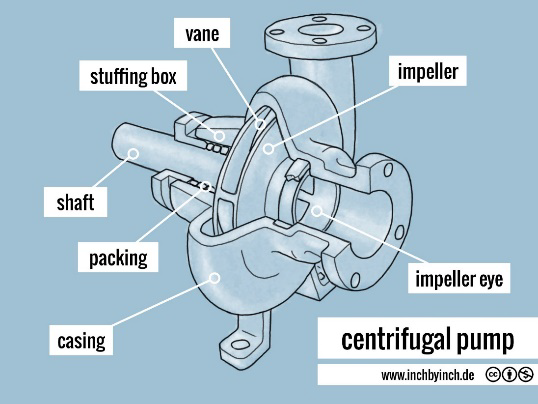 :::
:::
NOTE 1 NPSH3 means that during operation with NPSH available (NPSHA) equal to NPSH3, the extent of cavitation within the impeller is sufficient to cause a 3 % loss of head. NPSH3 is a performance characteristic of the first-stage impeller.
注1:NPSH3代表,在操作时,有效NPSH(称为NPSHA)等于因汽蚀导致扬程下降3%时的NPSH3的数值。NPSH3是首级叶轮的性能参数。
::: tip
解释:泵厂家在进行NPSH试验时,就是不断地降低NPSHA的数值,直到因为NPSHA数值下降过多发生了汽蚀,并导致泵的首级叶轮扬程发生了3%的下降,此时的NPSHA就等于NPSH3。只要首级叶轮不发生汽蚀了,后续叶轮就不会发生汽蚀了。
:::
NOTE 2 The datum elevations defined above for NPSH3 are in accordance with HI 14.6 (ISO 9906). NPSH3 values are provided by the vendor and if specified can be demonstrated by test.
注2:以上定义的NPSH3的基准高度应与ISO9906中HI14.6一致。NPSH3的数值应该由卖方提供,如果要求,应通过试验确定。
::: tip
解释:真实的NPSH3都是通过水的试验进行确定的。当然设计阶段也可以根据吸入比转速的公式估算泵的NPSH3值。
:::
6.1.10 The purchaser shall specify the NPSHA based on system conditions at the rated flow. The datum elevations for NPSHA shall be the estimated shaft centerlines for horizontal pumps and the estimated suction- nozzle centerlines for vertical pumps.
买方应该指明基于额定流量下,系统的NPSHA值。对于水平泵来说,NPSHA的计算基准高度是轴中心线的位置,对于立式泵来说,NPSHA的计算基准高度是吸入管口处。
NOTE 1 At the beginning of a project, actual elevations of pump shaft and suction nozzle centerlines are estimates based on preliminary information. As the project develops, the final pump geometry is provided by the vendor and the purchaser designs the final pump installation. At that point, the final datum elevations for NPSHA can be determined.
注1:项目初始阶段,真正的泵轴和吸入口中心线的高度需要根据以往项目信息估计。随着项目进展,卖方提供了最终的泵外形图,并且买方设计了泵的最终安装高度,至此,NPSHA最终基准高度才能被确定下来。
::: tip
解释:因为NPHSA由设计院工艺专业提供,需要计算到泵的入口位置。但是泵的入口高度无法确定(泵还没有采购),此时就需要估算一个泵的安装高度。一般按照0.51m中的某个数进行估算,但是如果买的泵的安装高度(包括泵的安装底座)超过0.51m的估算值,此时要重新核算NPSHA,并校核NPSHA与NPSH3的余量。
比如,一台泵的前期的NPSHa为4m(基于泵中心线的安装高度为1m的情况下),实际买的泵的NPSH3为3m,看似合理但是,泵是带有油站的,导致泵的中心线的实际安装高度为1.5m,这样,真实的NPSHA就变成了3.5m。NPSH差值就只有0.5m的,操作弹性就降低了。
:::
NOTE 2 The purchaser determines the final datum elevation for NPSHA based on the purchased pump and the final installation design. The final NPSHA can then be calculated based on the final datum elevation. The purchaser can record the final NPSHA value.
注2:买方根据最终购买的泵的外形图和安装设计才确定了NPSHA的最终基准高度。最终的NPSHA才能根据最终的基准(安装)高度计算出来。买方应该记录最终的NPSHA的数值。
NOTE 3 The NPSH margin is calculated as the difference of the final NPSHA and the NPSH3 at the common datum defined by HI 14.6 (ISO 9906). The purchaser can record the final NPSH margin value.
注3:NPSH的差值(余量)通过计算最终的NPSHA和NPSH3的差值得到(NPSH3通过ISO9906 HI14.6的基准面定义)。买方记录最终的NPSH差值。
NOTE 4 The purchaser considers an appropriate NPSH margin. Acceptable minimum NPSH margins vary by pump type and service. In establishing the NPSH margin, the purchaser and the vendor recognize the relationship between minimum continuous stable flow and the pump s suction-specific speed. In general, minimum continuous stable flow increases as suction-specific speed increases. However, other fa
ctors, such as the pump s energy level and hydraulic design, the pumped liquid, and the NPSH margin, also affect the pump s ability to operate satisfactorily over a wide flow range. Pump design that addresses low-flow operation is an evolving technology, and selection of suction-specific speed values and NPSH margins can take into account current industry and vendor experience.
注4:买方考虑合适的NPSH差值。根据泵的种类和工作环境不同,可接受的最小NPSH差值也不同。在确定 NPSH 余量时,买方和卖方应认识到最小持续稳定流量与泵吸入比转速之间的关系。一般来说,最小连续稳定流量随着吸入比转速的上升而上升。然而,其他因素,比如泵的能量水平和水力设计,泵送流体和NPSH差值都会影响泵在宽流量范围内满意运行。解决低流量泵的设计是一项不断发展的技术,在选择吸入比转速和 NPSH 余量时,可考虑当前行业和供应商的经验。
::: tip
解释:API610标准并没有规定NPSHA与NPSH3的差值具体是多少。根据一般经验,可取0.6~1m,如果差值小于1m,一般要求进行NPSH试验,从而验证是否满足NPSH差值。如果差值大于1m,可以不做NPSH试验。
:::
6.1.11 The pump suction-specific speed shall be calculated in accordance with Annex A. If the purchaser specifies a suction-specific speed limit, the pump shall have a calculated suction-specific speed not greater than that specified limit.
吸入比转速根据附录A计算。如果买方指定了吸入比转速的限值,泵计算的吸入比转速不应该超过这个限值。
::: tip
解释:吸入比转速(也称汽蚀比转速),这个比转速是汽蚀情况和可靠性的一个指标。根据附录A中的计算公式,吸入比转速越高,则说明其抗汽蚀性能越好(NPSH3越小),但是有依据表明,NPSH3并不是越小越好,过小的NPSH3会使得泵的可靠性降低。因此,常常把吸入比转速控制再11000附近(美制单位下),根据11000的汽蚀比转速,可以反向估算NPSH3。
:::
6.1.12 Pumps that handle liquids more viscous than water shall have their water performance corrected in accordance with HI 9.6.7. Correction factors used for viscous liquid shall be submitted with both sales proposal curves and final test curves.
如果泵送流体比水的粘度大,那就应该根据HI9.6.7对基于水的性能进行修正。粘性流体的修正系数应该随着报价曲线和最终测试曲线一同提交。
::: tip
解释:一般来说,如果泵送介质的粘度超过20cp,而性能试验时都是采用水,则就必须对性能曲线进行粘度的修正。修正过程是查表和查图的计算过程。
:::
6.1.13 If parallel operation is specified and the pumps are not individually flow controlled, the following is required:
如果泵是并联运行的,且泵不是独立流量控制的,有如下要求:
::: tip
解释:泵不是独立流量控制的意思是,并联运行的泵的入口或出口不设置流量控制阀或通过变频来分别控制每台泵的流量。
:::
a) the pump head curves shall be continuously rising to shutoff;
泵的扬程曲线应该从额定点到关闭点是连续上升的
b) the head rise from rated point to shutoff shall be at least 10 %;
从额定点到关闭点的扬程升量应最少10%
c) the head values of the pumps at any given flow within the preferred operating range shall be within 3 % of each other for pumps larger than 3 in. (80 mm) discharge.
对于排出口在3in(80mm)以上的泵来说,在优先工作区内任意给定流量下,各泵的扬程数值应该在3%的范围内。
::: tip
解释:之所以提出以上要求,是因为,对于2台并联运行的泵,如果两台泵在任意相同给定流量下的扬程偏差过大,会产生强泵和弱泵的区分,导致某些工况下,弱泵直接没有流量了。如下图所示,红色曲线是B泵曲线,蓝色曲线时A泵曲线,紫色是两台泵并联运行时的联合曲线。从图中可以看出由于两台泵在任意相同流量下扬程差距较大,导致两台泵并联运行时的联合曲线出现了拐点。当两台泵共同曲线运行在图中的方块点时,就会导致A泵变成了“强泵”吸走了大部分流量,而B泵变成了“弱泵”其流量会急剧减少以便能达到泵出口压力,从而导致B泵运行点偏离优先工作区甚至偏离允许工作区导致B泵出现损坏。
因此如果2台泵并联运行,应该尽量选择一模一样的泵。工程实际中也是这样要求的。
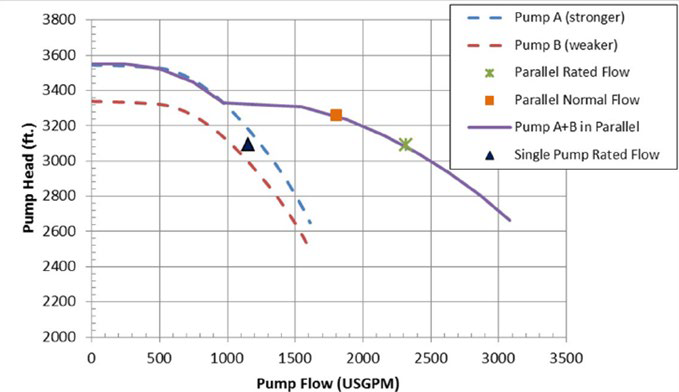 :::
:::
NOTE The above requirements are not necessary for pumps with individual adjustable speed drives (ASDs) controlled by individual flow measurements.
注:以上要求,不适用于有独立可变转速(ASDs)的泵,通过监测流量来控制转速。
6.1.14 If a discharge orifice is used as a means of providing a continuously rising head curve, this shall be stated in the proposal.
如果是通过排出口增加孔板的方式达到连续上升的扬程曲线的话,卖方应该在报价文件中说明。
::: tip
解释:排出口增加孔板,可能会导致曲线变陡峭。且放了孔板,泵在大流量下可能会发生阻塞工况,比如高速泵,其出口就有孔板,高速泵的曲线就存在流量断崖下跌的陡峭段。
:::
6.1.15 If specified, pump head curves shall be continuously rising from rated point to shutoff.
如指定,泵的扬程曲线应该为从额定点到关闭点连续上升的曲线
NOTE Pumps with a continuously rising head curve are preferred for all applications, but this is not possible with all pump types. Head curve shape is dependent on several factors specific to the pumps hydraulic design.
注:拥有连续上升扬程曲线的泵是所有场合都推荐的,但是这并不适用于所有泵型。扬程曲线的形状依赖于多因素,尤其是泵的水力设计。
::: tip
解释:连续上升的扬程曲线代表着,管路曲线和流量扬程曲线只有一个交点,是非常稳定的。但是有些超低比转速的泵容易有驼峰曲线,驼峰曲线与管路曲线有两个交点,会有不稳定工况。
:::
6.1.16 Pumps shall have a preferred operating region of 70 % to 120 % of BEP flowrate of the pump as furnished. Rated flow shall be within the region of 80 % to 110 % of the BEP flowrate of the pump as furnished.
% of the BEP flowrate.
泵BEP流量点的70%120%之间的操作范围应该是泵的优先工作区。额定流量点应该在BEP流量点的80%110%之间。BEP流量点的120%认为是曲线末端点。
::: tip
解释:这里用的是shall,也就是强制条款。但是下面的note又同意对词条的偏离。这有点矛盾,工程上一般不把这条作为废标项。
:::
NOTE 1 Setting limits for the preferred operating region and the location of rated flow are not intended to lead to the development of additional small pump sizes or preclude the use of high-specific-speed pumps. Small pumps that are known to operate satisfactorily at flows lower than the 70 % limit specified above and high-specific-speed pumps that can have preferred operating regions narrower than the region specified above can be offered, where appropriate.
注1:设定优先工作区和额定流量点的限制,并不是为了开发更多小泵型或者排除使用高比转速的泵。流量低于70%的BEP下操作时运行比较满意的小泵,以及拥有更窄优先工作区的高比转速的泵也可以在合适的情况下使用。
::: tip
解释:也就是同意对上述一条的偏离。
:::
NOTE 2 "BEP flowrate of the pump as furnished" refers to the BEP of the pump with the impeller diameter selected to develop rated head at rated flow.
注2:"所提供泵的 BEP 流量 "是指为在额定流量下产生额定扬程,所选的叶轮直径下,泵的 BEP 流量点。
::: tip
解释:BEP是流量点,之前也说过了,每个直径下的叶轮,都有一条曲线,每条曲线都有一个BEP点。
:::
NOTE 3 For allowable operating region, see 3.1.1.
注3:对于允许工作区,见3.1.1
NOTE 4 Generally, pumps with BEP flowrates between the rated and normal points require less energy to operate than pumps with BEP flowrates greater than the specified rated point.
注4:一般来说,BEP点在额定流量点和正常流量点之间的泵与BEP点大于额定流量点的泵相比,运行时需要更加节能。
::: tip
解释:BEP点尽量在数据表中的正常流量和额定流量之间,这样运行节能。因为实际工程中,泵常常在正常点和额定点之间运行,符合本条时,此时的效率往往很高。
:::
6.1.17 The pump specific speed and the pump suction-specific speed shall be calculated in accordance with Annex A.
应该根据附录A计算泵的比转速和吸入比转速。
6.1.18 For pumps equipped with ASDs, the vendor shall determine the minimum allowable speed of the equipment and record the value.
对于带有ASDs(可变转速设备)的泵来说,卖方应该确定泵的最小允许转速,并且记录这个数值。
::: tip
解释:ASD一般指的是变频,或汽轮机等变速设备。对于变频器来说,也有变频的设计的下限,比如按照25~50HZ设计的变频器,如果长期运行在20HZ会导致发热问题。因此,25HZ对应的转速就是泵的最小转速。汽轮机同样的也有最小转速的要求,转速太小可能会使得轴承不能充分的形成油膜。
:::
6.1.19 The vendor shall provide maximum expected A-weighted sound pressure level (SPL) for the equipment.
卖方应该提供设备的最大的预期A级加权声压值(SPL)
::: tip
解释:就是噪声的要求。
:::
6.1.19.1 Control of the SPL of all equipment furnished shall be a joint effort of the purchaser and the vendor who has unit responsibility.
控制泵的SPL数值,应该是买方和成套责任方双方的共用责任。
6.1.19.2 If specified, the equipment furnished by the vendor shall conform to a maximum allowable SPL specified by the purchaser.
如指定,卖方提供的设备应该满足买方要求的最大允许SPL值。
NOTE ISO 3740 [7], ISO 3744 [8], and ISO 3746 [9] can be consulted for guidance.
注:ISO 3740 [7], ISO 3744 [8], 和 ISO 3746 [9]可以提供指导。
::: tip
解释:一般来说,离着设备1m处,最大允许设备噪音为85分贝。
:::
6.1.20 For pumps developing head greater than 650 ft (200 m) per stage and absorbing more than 300 hp (225 kW) per stage, the radial clearance between the diffuser vane or volute tongue (cutwater) and the periphery of the impeller vane shall be at least 3 % of the maximum impeller vane-tip radius for diffuser designs and at least 6 % of the maximum blade-tip radius for volute designs.
对于单级扬程大于650ft(200m)的泵,和单级功率超过300hp(225kW)的泵来说,diffuser vane(或者volute tongue(cutwater))与叶轮边缘的间隙值,应该至少为3%的最大叶轮叶尖半径(对于导流壳设计的泵);应该至少是6%的最大叶尖半径(对于蜗壳设计的泵)。
::: tip
解释:本条意思是,对于大泵(扬程大于200,单机功率225),间隙要留的足够,不能为了提高效率减少间隙。
cutwater的意思是蜗舌,示意图如下。下图中,对于双蜗壳,有两个cutwater,对于单蜗壳,有一个cutwater。这样就好理解叶轮与cutwater之间的间距了。
右图,是叶轮和diffuser vane图,可见两者间隙很小。
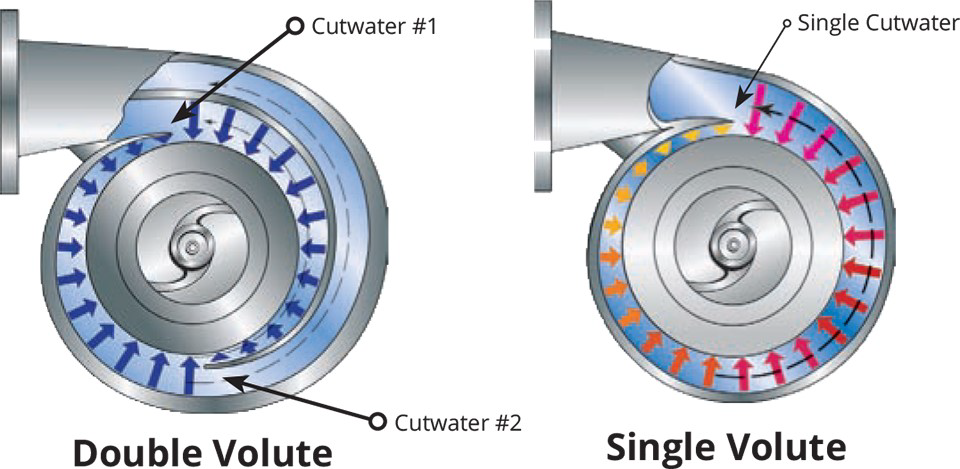
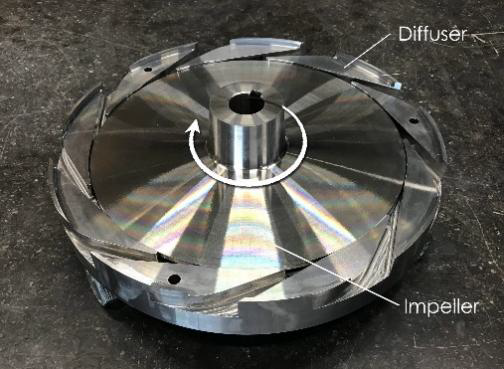 :::
:::
NOTE 1 The maximum impeller vane-tip radius is the radius of the largest impeller that can be used within the pump casing (see 6.1.6). The clearance, P, expressed as a percentage, is calculated using Equation (1):
注1:最大叶轮叶尖半径的意思是,泵壳内可使用的最大叶轮半径。间隙P(单位是%),可以根据公式(1)计算

式中
- R2 is the radius of volute or diffuser inlet tip;
- R2代表volute(蜗壳)或者diffuser(导流壳)的入口尖端
- R1 is the maximum impeller blade tip radius.
- R1代表最大叶轮叶片尖端半径
NOTE 2 It is common practice for the impellers of pumps covered by this section to be modified after initial test to correct hydraulic performance by underfilling, overfilling, -cutting. Any such modifications are documented in accordance with L.3.2.2.
注2:在初始的试验后再修正水力性能是非常常见的,常见的修正方法有(减料填充,增料填充,或者V型切割),任何类似的修正应该根据L.3.2.2进行记录。
::: tip
解释:by underfilling, overfilling, V -cutting都是叶轮的修正手段。
:::
6.1.21 Pumps operating above 3600 r/min and absorbing more than 400 hp (300 kW) per stage can require even larger running clearances and other special construction features. For these pumps, specific requirements shall be agreed upon by the purchaser and the vendor, considering actual operating experience with the specific pump types.
如果泵的操作转速在3600rpm以上或单级功率在400hp(300Kw)以上时,可能需要更大的运行间隙和特殊的结构特点。对于这些泵,买卖双方应该考虑特定泵型下的实际运行经验,从而共同制定特定条款。
::: tip
解释:泵越大,转速越高,需要的运转间隙尽量越大。因为泵越大,积累的热膨胀可能越大。
:::
6.1.22 The need for bearing housing cooling shall be determined by the vendor, and the method shall be agreed upon by the purchaser. Fan cooling for the bearing housing shall be the first choice. If fan cooling is inadequate, one of the plans in Annex B shall be selected. The cooling system shall be suitable for operation with the coolant type, pressure and temperature specified by the purchaser. The vendor shall specify the required flow.
卖方确定是否需要轴承箱冷却,并且冷却方式应该得到买方同意。轴承箱的风扇冷应该是首选。如果风扇冷不满足要求,应该选择附录B中的一种方案。冷却系统应该适应买方提供的冷却剂的种类、压力、温度等。卖方提供所需冷却剂的流量。
::: tip
解释:轴承箱一般不设置风扇冷,而是设置水冷。一般来说,泵送介质温度超过120℃就应尽量设置轴承箱冷却了。轴承箱冷却有盘管式或者夹套式。
:::
NOTE To avoid condensation in the bearing housing, the minimum temperature of the cooling-liquid at the inlet to bearing housing is maintained above the ambient air temperature.
注:为了防止轴承箱内的冷凝,冷却液体的最小温度应该在周围空气温度以上。
::: tip
解释:轴承箱的冷却液体一般是循环水,循环水一般入口时32℃,一般大于空气温度。如果低于了空气温度,轴承箱中的空气可能发生冷凝,导致润滑油进水。
:::
6.1.23 Jackets, if provided, shall have clean-out connections arranged so that the entire passageway can be mechanically cleaned, flushed, and drained.
如果提供夹套,应该有清洁整个流道的接口,从而方便对整个流道进行机械清洁、冲洗、排凝。
::: tip
解释:如下图,是夹套式轴承箱。
 :::
:::
6.1.24 Jacket systems, if provided, shall be designed to prevent the process stream from leaking into the jacket or the heat transfer medium from leaking into the process. Jacket passages shall not open into casing joints.
如果提供了夹套系统,设计上应该防止工艺流体渗透到夹套中,或者防止传热介质渗透到工艺流程中。夹套流道不应开口在壳体的结合面上。
::: tip
解释:这句话的工艺流体,就是指的润滑油。传热介质就是指的冷却水。如上图,夹套设置在轴承箱的下半部分。且应该对其进行水压试验,保证不漏水。有些泵厂,不做夹套的水压,导致循环水漏到了油池里。
:::
6.1.25 Unless otherwise specified, water-cooling systems shall be designed for the conditions on the water side as given in Table 2.
除非另有规定,水冷却系统的水侧应该按照表2的要求进行设计。
6.1.26 Provisions shall be made for complete venting and draining of cooling-water systems.
应该提供冷却水系统的完全排气和排液措施。
::: tip
解释:冷却水系统应该设置低点排凝和高点排气,这对密封冲洗系统来说尤为重要。
:::
6.1.27 The vendor shall notify the purchaser if the criteria for minimum temperature rise and velocity over heat exchange surfaces result in a conflict. The criterion for velocity over heat exchange surfaces is intended to minimize water-side fouling; the criterion for minimum temperature rise is intended to minimize the use of cooling water. If such a conflict exists, the purchaser shall approve the final selection.
如果换热器的最小温升要求和表面流速的要求相矛盾,卖方应该通知买方。设置换热器流速要求的本意是将水侧结垢的可能性最小化。设置最小温升要求的本意是将冷却水的消耗最小化。如果存在矛盾,最终选择由买方应该批准。
::: tip
解释:要求最小温升大时,流速肯定不能太大。所以两者可能存在矛盾的情况。
:::
==Table 2 Water-cooling Systems Conditions on the Water Side==
==表2——冷却水系统——水侧条件==
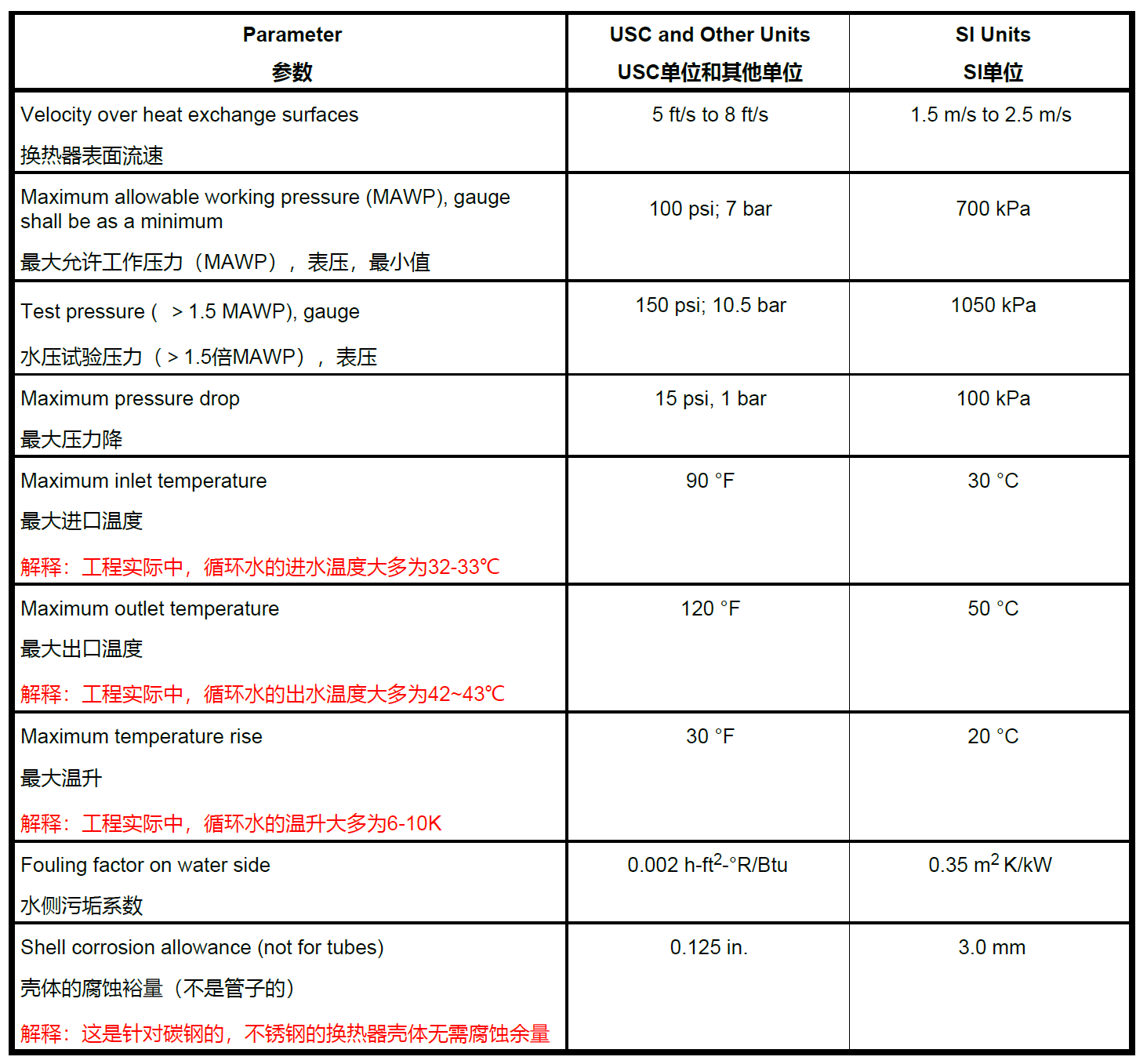
6.1.28 The arrangement of the equipment, including piping and auxiliaries, shall be developed jointly by the purchaser and the vendor. The arrangement shall provide sufficient clearance between equipment and piping and auxiliaries to allow safe access for operation and maintenance. (For OH2 type pumps, see Figure 40.)
设备布置,包括管道和附件的布置,应该由买卖双方共同努力完成。布置上,应该在设备和管道和附件之间留有足够的安全通道空间,以便操作和维护。(对于OH2泵,见图40)
6.1.29 Electrical Classification电气分区
6.1.29.1 Locations for installed equipment can be classified as hazardous electrical areas or they can be unclassified. An unclassified area is considered nonhazardous; therefore, motors, electrical instrumentation, equipment, components, and electrical installations for unclassified areas are not governed by hazardous area electrical codes.
设备安装位置可以被划分为电气危险区或者不划分。不划分区域代表无危险,因此,不划分区域的电机,电子仪表,设备,部件和电气设备的安装不受危险区电气规范的约束。
6.1.29.2 If an installation location is classified as hazardous, motors, electrical instrumentation, equipment,components, and electrical installations shall be suitable for the hazardous electrical area classification designation as specified.
如果安装区域被划分为危险区,电机,电子仪表,设备,部件和电气设备的安装应该适用于电气危险区的划分。
::: tip
解释:危险分区分为气体危险区(0区,1区,2区)和粉尘危险区(20区,21区和22区),其中0区和20区最危险,表示正常情况下就有危险的气体或者粉尘存在。石油化工中,多见2区或22区,表示正常情况下不危险,意外情况下危险。对电气设备来说,不同分区有不同的防爆要求。
:::
6.1.29.3 All applicable electrical codes shall be specified. Local electrical codes that apply shall be provided by the purchaser upon request.
应该指定所有适用的电气规范。当地的电气规范如果适用,也应该由买方根据要求提供。
6.1.30 Oil reservoirs and housings that enclose moving lubricated parts, such as bearings, shaft seals, highly polished parts, instruments and control elements, shall be designed to minimize contamination by moisture, dust, and other foreign matter during periods of operation and idleness.
存在移动润滑件(比如轴承,轴封,剖光部件,仪表和控制元件)的油箱和轴承箱,应该设计成,在运行或者停运期间,防雾气,防灰尘和防其他外来物质的形式。
::: tip
解释:防止轴承箱进入雾气或者灰尘,就需要比较好的油封。API严格要求不得使用唇封。实际工程中,油封多适用铸铝的迷宫密封,或者轴承隔离器(isolator)或者磁力密封。
:::
6.1.31 All equipment shall be designed to permit rapid and economical maintenance. Major parts, such as casing components and bearing housings, shall be designed and manufactured to ensure accurate alignment on reassembly. This can be accomplished by the use of shouldering, dowels, or keys.
所有设备应该设计成允许快速和经济的维护的形式。主要部件,比如泵壳和轴承箱,应该设计和制造成,可以保证正确对中和装配的形式(可以通过使用肩,销和键的方式实现。)
6.1.32 Except for vertically suspended pumps and integrally geared pumps, pumps shall be designed to permit removal of the rotor or inner element without disconnecting the suction or discharge piping or moving the driver.
除了立式悬吊泵和集成齿轮泵,泵应该设计成,允许无需拆开进口管道到或者移动驱动就可以移除转子和内部部件的形式。
::: tip
解释:立式集成齿轮泵(如下图,也就是立式高速泵)要拆卸叶轮或者更换密封,就必须要把电机移走。卧式高速泵就无需拆卸管口或者电机就可以更换叶轮部件。
 :::
:::
6.1.33 The pump and its driver shall perform on their test stands and on their permanent foundation within the vibration acceptance criteria specified in 6.9.4. After installation in accordance with the vendor’s requirements, the performance of the pump and driver as a combined unit shall be the joint responsibility of the purchaser and the vendor who has unit responsibility.
泵及其驱动器在试验台上和永久性地基上的性能,应符合 6.9.4 规定的振动验收标准。按照供应商的要求安装后,泵和驱动装置作为一个组合装置的性能应由买方和负有整体成套责任的供应商共同负责。
::: tip
解释:工程实际中,试验台上的泵的性能完全由厂家负责。现场的性能保证,受多方面影响,但是如果买方提供了符合买方要求的条件后,泵的性能保证还是应该厂家负责。
:::
6.1.34 Many factors can adversely affect site performance. These factors include such items as piping loads, alignment at operating conditions, supporting structure, handling during shipment, and handling and assembly at the site. If specified, the vendor s representative shall witness:
很多不利因素可以影响现场性能。这些因素包括,管道应力,操作工况时的对中,支撑结构,运输过程中的处理,现场组装等。如果要求,卖方代表应该见证:
- a) a check of the piping alignment performed by unfastening the major flanged connections of the equipment;
管道对中的检查,通过松开设备主要法兰的螺栓实现
::: tip
解释:就是看看松开螺母,看看螺栓是否可以很轻松的取下来。无应力配管。
:::
b) the initial shaft alignment check at ambient conditions;
大气条件下的初始轴对中的检查
c) shaft alignment at operating temperature, i.e. hot alignment check.
操作工况下轴对中情况。就是热对中检查。
NOTE Refer to API 686 for basic guidelines for conducting piping alignments, shaft cold alignments, and shaft hot alignments.
注:管道对中,轴的冷对中和轴热对中的指导,可以参考API686
::: tip
解释:工程实际中,一般不会要求厂家见证或检查管道与泵的对中。
:::
6.1.35 Spare and all replacement parts for the pump and all furnished auxiliaries shall, as a minimum, meet all the criteria of this standard.
备件、所有可更换部件以及提供的所有辅助设备,应该至少满足本标准的所有要求。
6.1.36 Equipment, including all auxiliaries, shall be designed for outdoor installation and the specified site environmental conditions. The vendor shall advise of any equipment protection required for the jobsite location (i.e. winterization for low ambient temperatures, or protection against unusual humidity, dusty or corrosive conditions, etc.).
设备,包括辅助设备,应该设计成满足户外安装和特定现场条件的形式。卖方应该建议设备的所有保护措施(为了满足现场环境),比如(低温工况的防寒措施,或者特别潮湿的保护措施,或者灰尘或腐蚀环境的防护措施等。)
6.1.37 Bolting and Threads螺栓和螺纹
6.1.37.1 The details of threading shall conform to ASME B1.1, ASME B1.13M, or ISO 261. The vendor shall advise the type of bolting used on the pump.
螺纹的细节应该遵循ASME B1.1,ASME B1.13M或者ISO 261. 卖方应该推荐泵上使用的螺栓类型。
::: tip
解释:ASME B1.1为英制螺纹,ASME B1.13M或者ISO 261为公制螺纹
:::
6.1.37.2 If ASME B1.1 threads have been specified, the thread series shall be the varying-pitch series UNC for sizes up to 1 in. and 8 UN for sizes greater than 1 in. All threads shall be Class 2 or 3.
如果指定使用了ASME B1.1 螺纹,那尺寸到了1英寸前的螺栓螺纹系列应该是UNC的可变螺距系列,大于1英寸的应该使用8UN系列,所有螺纹应该是等级2或者等级3的。
::: tip
解释:UNC(粗牙)螺纹和UNF(细牙)螺纹
Class 2 螺纹等级是一种普通等级,也称为一般用途等级。它是公制螺纹连接中常见的等级之一。Class 2螺纹具有适度的质量和精度,适用于大多数一般工程应用。
Class 3 螺纹等级是一种较高等级,也称为精密等级。它是公制螺纹连接中更高精度的等级。Class 3螺纹具有更高的质量和更严格的精度要求,适用于需要更高精度和更严苛环境的应用,如精密仪器、航空航天和高科技领域。
:::
NOTE Coatings on pressure casing bolting are sometimes not practical because they can alter the class of the threads. This alteration can affect tightening requirements of the bolting.
注:承压壳体螺栓的涂层可能不适用,因为他们可以改变螺栓的等级。这种改变可以影响螺栓的紧固要求。
6.1.37.3 If ISO 261 and ISO 262 have been specified, the thread series shall be coarse. Threads shall be Class 6g for bolting and studs and Class 6H for nuts.
如果指定ISO261和ISO262标准,那么螺纹系列应该是粗牙螺纹。螺栓和螺柱的螺纹等级应该是6g,螺母的螺纹等级应该是6H级。
::: tip
解释:bolting表示螺栓,stud表示螺柱,screw表示螺钉,nut表示螺母。具体区别如图:
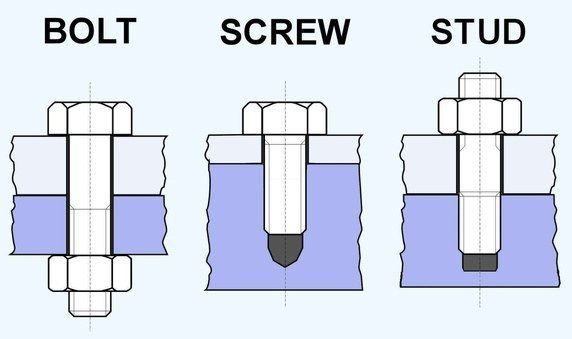 :::
:::
6.1.37.4 Commercial fasteners shall be manufactured in accordance with the requirements of ASME B18.18.2M or shall be procured from distributors having quality plans in accordance with ASME B18.18.2M.
商用紧固件应该根据ASME B18.18.2M的要求制造,或者从分销商那里购买,分销商应该有符合ASME B18.18.2M的质量计划。
6.1.38 Adequate clearance shall be provided at all bolting locations to permit the use of socket or box wrenches.
所有存在螺栓的地方应该由足够的空间,以便使用扳手或者套筒扳手
6.1.39 Unless otherwise specified or agreed, studs shall be supplied on all main casing joints, and all other joints and connections shall be supplied with external hexagon-head bolting.
除非另有说明或者约定,壳体主分面的连接应该使用螺柱,其他接头和连接应该使用外部六角头螺栓。
::: tip
解释:对于本条有些厂家是不执行的,对于垂直剖分的OH2泵体,壳体的主分面多使用螺钉连接。而对于水平剖分的BB3泵,主分面多使用螺柱。
external hexagon-head bolting如下图
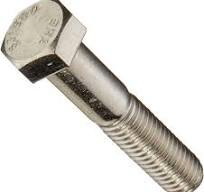
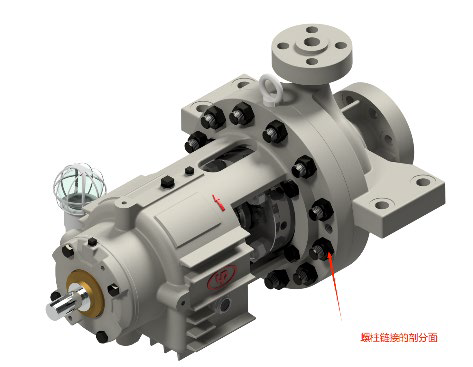
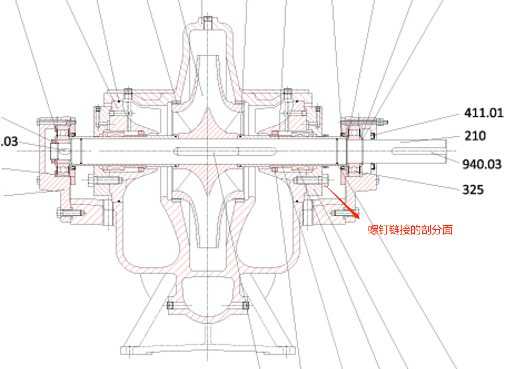 :::
:::
6.1.40 Fasteners (excluding washers and headless set-screws) shall have the material grade and manufacturer s identification symbols applied to one end of studs 3/8 in. (10 mm) in diameter and larger and to the heads of bolts 1/4 in. (6 mm) in diameter and larger. If the available area is inadequate, the grade symbol may be marked on one end and the manufacturer s identification symbol marked on the other end. Studs shall be marked on the exposed end.
对于一头≥3/8英寸(10mm)的螺柱,和螺栓头≥1/4英寸(6mm)的紧固件(不包括垫片和无头螺钉),应该有材料等级和制造商的标识符号。如果空间受限,那么等级符号可以标记在一头,制造商标识符号标记在另一头。应该标在螺柱漏出的一端处。
NOTE A set-screw is a headless screw with a hexagonal socket in one end.
注:A set-screw是那种无头的螺钉,一端有一个六边形的槽
::: tip
解释:A set-screw附图如下:
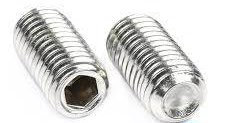 :::
:::
6.1.41 Pressure casing fasteners shall be not less than 0.5 in. (12 mm) diameter.
承压壳体的紧固件应该不小于0.5英寸(12mm)直径。